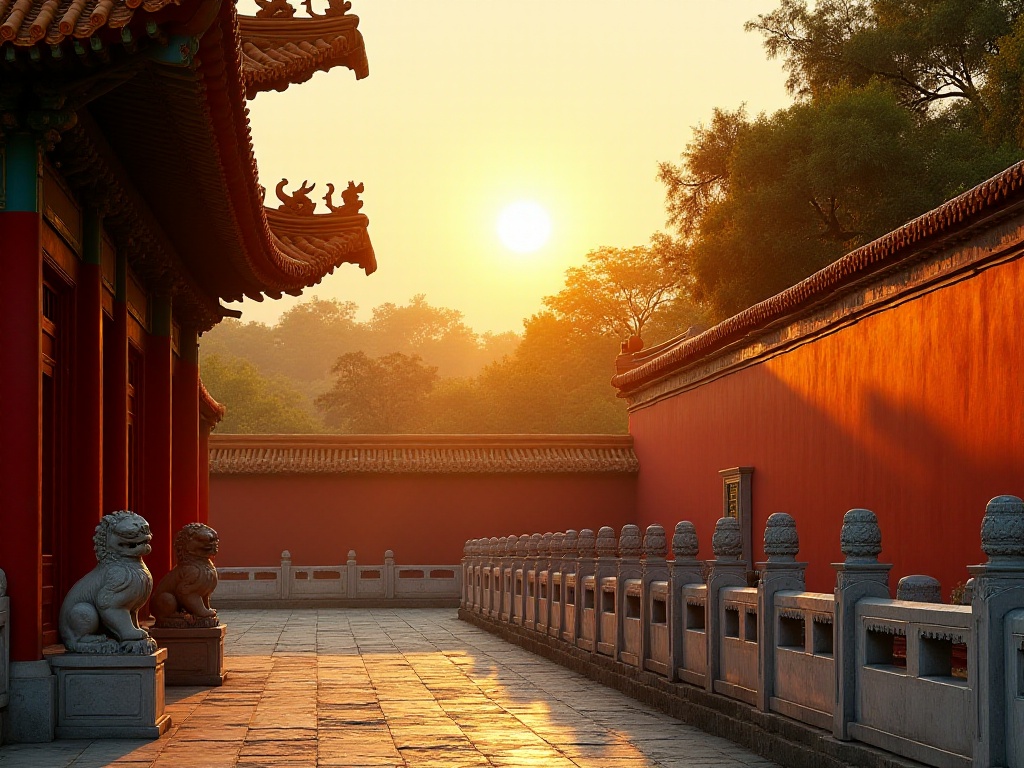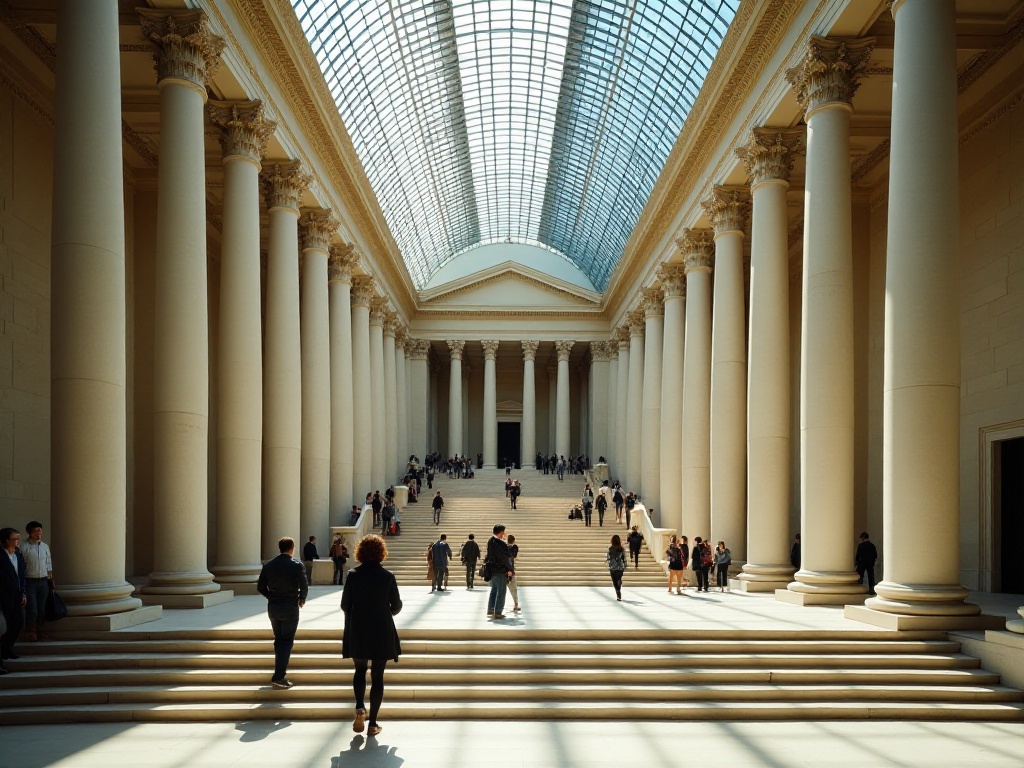First Encounter with the British Museum
I'll never forget the first time I walked into the British Museum. It was a sunny afternoon, a rare good weather day in London. From a distance, the British Museum's magnificent Greek Revival architecture looked like a majestic palace of art. Forty-six Ionic columns stood in neat rows, supporting the museum's iconic triangular pediment, exuding both grandeur and elegance.
As a Chinese student who had just arrived in London, I climbed the museum's steps with overwhelming excitement. Pushing open the heavy glass doors, I was greeted by the breathtaking Great Court. This central courtyard, covered by a glass dome, allowed natural light to fall softly on the white marble floor. Visitors from around the world filled the space, their different languages interweaving in the air, yet somehow not creating chaos but rather adding vitality to this historic hall.
During my two years of study in London, I visited the British Museum almost every month. Sometimes I accompanied friends, other times I wandered through the galleries alone. Each visit brought new surprises, as if this museum could never be fully explored. What moved me most was that the British Museum is free for everyone. Here, whether rich or poor, all can equally enjoy the enrichment that art and history provide.
Moments of Awe
The sheer volume of the British Museum's collection is staggering. With over 8 million artifacts, it covers every aspect of human civilization. From Egyptian mummies to Chinese bronzes, from ancient Greek marble statues to Persian reliefs, each piece tells its own unique historical story.
I often spent long periods in the Egyptian galleries, especially in front of the Rosetta Stone. This black basalt stone is inscribed with three scripts: ancient Egyptian hieroglyphs, Demotic script, and ancient Greek. It was by comparing these three scripts that French scholar Champollion successfully deciphered Egyptian hieroglyphs. Standing before the stone, I would imagine Champollion working by lamplight, meticulously comparing these mysterious symbols until he finally unveiled the secrets of a writing system buried for thousands of years.
The Egyptian mummy gallery also left a deep impression on me. The exhibition space uses soft lighting to create a mysterious and solemn atmosphere. Through advanced CT scanning technology, visitors can see the internal structure beneath the mummy wrappings. These remains, preserved for thousands of years, offer us a glimpse into ancient Egyptian embalming techniques and burial customs.
In the Asian galleries, I was always drawn to the Chinese artifacts. The exquisite bronzes, porcelain, and paintings all demonstrate the profound depth of Chinese civilization. Once, I met a British professor in the gallery who was full of praise for Chinese bronze casting techniques. We talked for a long time, from the symbolic meanings of Shang and Zhou dynasty bronze patterns to modern archaeological discoveries. Such cross-cultural exchanges made me deeply appreciate the power of culture.

Connection with the Forbidden City
Speaking of museums, one cannot overlook the Palace Museum in Beijing. This Forbidden City, built in the fourth year of the Yongle Emperor's reign in the Ming Dynasty, has witnessed nearly 600 years of Chinese history. After the Palace Museum was established in 1925, this former imperial palace officially opened to the public, becoming an important window showcasing Chinese civilization.
I remember my first visit to the Forbidden City, choosing an early morning on a workday. The Forbidden City was especially peaceful in the early morning, with sunlight filtering through the tall palace walls, casting a soft glow on the golden glazed tiles. Walking across the vast squares, I couldn't help but imagine how this place once bustled with carriages and gathered dignitaries.
The Forbidden City's architecture itself is a work of art. The intricate dougong brackets, elaborate painted decorations, and magnificent halls all reflect the wisdom of ancient Chinese craftsmen. On rainy days, I particularly enjoy observing the palace's drainage system. Those carefully designed gutters and carved stone drains remain a perfect architectural drainage solution even by modern standards.
The Palace Museum's collection is astounding, with over 1.8 million artifacts in its possession. From imperial treasures to exquisite folk crafts, from historic calligraphy and paintings to royal bronze collections, each piece tells a story of Chinese civilization's brilliant history.
My favorite is the ceramics gallery. The porcelain from various dynasties displays a rainbow of glazes and elegant forms. I'm especially drawn to the Yuan Dynasty blue and white porcelain, where the blue color bleeds into the white porcelain creating an effect that makes one marvel at the ancient aesthetic sensibility. Once, I met a Japanese visitor in the ceramics gallery who couldn't stop praising Chinese porcelain craftsmanship. Though we couldn't speak each other's language, our appreciation for beauty transcended this barrier.
Specialized Features
Each specialized museum has its unique charm. For instance, the Terracotta Warriors Museum in Xi'an gave me a completely different kind of profound experience. The first time I walked into Pit 1, I was overwhelmed by a sensation that took a long time to process. Thousands of clay soldiers stood in formation, each with distinct facial features and expressions, like an army that had traversed time and space.
Archaeologists discovered that these terracotta warriors were made to life-size specifications, with each warrior having unique facial features, clothing, and hairstyles. This extreme attention to detail commands respect for the craftsmanship of Qin Dynasty artisans. The museum guide told me that creating these warriors required multiple steps, from clay selection to modeling and firing, with no room for error at any stage.
I've also visited the Mogao Caves in Dunhuang, an artistic treasure house built into steep cliffs, preserving numerous precious murals and sculptures. The use of modern technology has enhanced the visiting experience. Through digital galleries, visitors can closely appreciate the exquisite murals on cave ceilings and understand the evolution of painting styles across different periods.

The Appeal of Technology
Speaking of modern technology museums, the London Science Museum left a deep impression on me. Here, exhibitions go beyond traditional static displays, filled instead with interactivity and engagement. The museum has many hands-on experimental areas where visitors can experience scientific principles firsthand.
I particularly love the human space flight history section. From the earliest hot air balloons to modern spacecraft, from the Wright brothers' airplane to models of the Apollo lunar module, it clearly shows humanity's journey to conquer the skies. Through VR equipment, I even experienced the sensation of a space walk, an unforgettable feeling of weightlessness.
At the Deutsches Museum in Munich, Germany, I encountered even more amazing technological exhibits. Here you can find a replica of the world's first electronic computer, reconstructed Nobel laboratory scenes, and even a real mine exhibition area. Walking through the museum feels like taking a journey through centuries of technological advancement.

Deep Exploration
During each museum visit, I pay special attention to the stories behind the exhibits. For instance, seeing Chinese bronzes at the British Museum prompted me to reflect on the history of lost cultural relics. How did these artifacts end up overseas? What journey did they take? These questions led me to delve deeper into the history of cultural exchange between China and other countries.
At the Louvre in Paris, I saw numerous artworks from around the world. From the Venus de Milo to Leonardo da Vinci's Mona Lisa, each work carries the aesthetics and values of its particular era. I especially enjoy finding a quiet corner to observe visitors' reactions to the artworks. Some stand in contemplation, others engage in excited discussion, while others quietly sketch – these are precious moments of dialogue between art and humanity.
The Chinese art gallery at New York's Metropolitan Museum of Art also gave me many insights. Seeing foreigners so seriously studying and displaying Chinese culture made me feel both proud and somewhat ashamed. Many of their interpretative angles were unique, giving me new perspectives on my own culture.

Looking to the Future
With technological advancement, museums are offering increasingly diverse ways of exhibition. Many museums now use AR technology, allowing visitors to see three-dimensional reconstructions of artifacts through their phones. This technology is particularly suitable for displaying damaged artifacts, helping people imagine their original appearance.
Some newer museums I've visited have adopted smart guide systems. Through mobile apps, visitors can customize their tour routes based on their interests and receive detailed audio explanations. This personalized visiting experience makes museums more accessible and interesting.
Virtual museums are also a new trend. Through the internet, people can appreciate precious collections from around the world without leaving home. Although this experience can't compare to visiting in person, it breaks down geographical barriers, allowing more people to access outstanding cultural heritage.
My museum experiences have taught me that cultural charm is eternal. Whether ancient artifacts or modern artworks, they all tell stories of human civilization. Each museum is like an open book, waiting for us to explore, discover, and contemplate.
Reflecting on these years of museum visits, I feel the greatest gain isn't just seeing precious artifacts, but gaining a deeper understanding of human civilization through them. Museums aren't just places to collect and display artifacts; they're bridges connecting past and present, facilitating dialogue between Chinese and foreign cultures.
I hope more people will visit museums, experience the charm of culture, and discover their own museum stories. Let us together, in these halls that carry human wisdom, search for the cultural imprints of our era.


